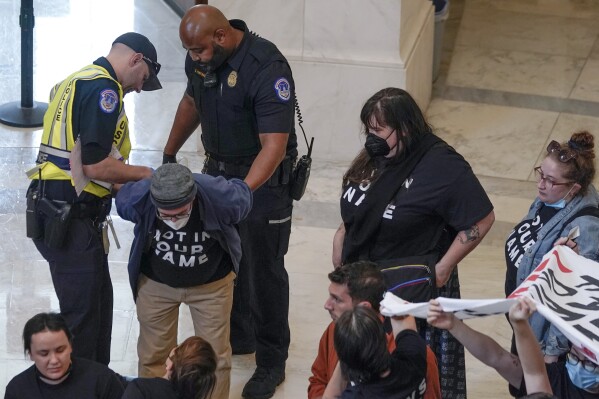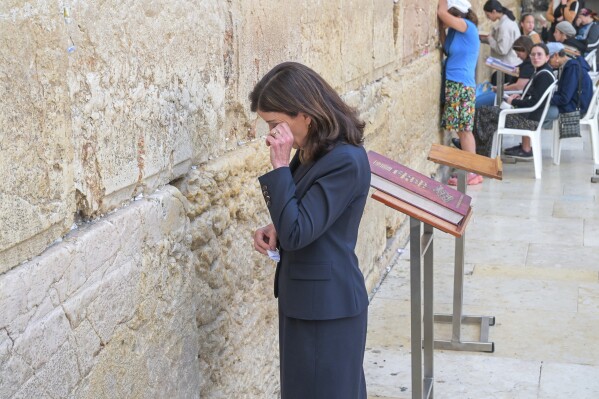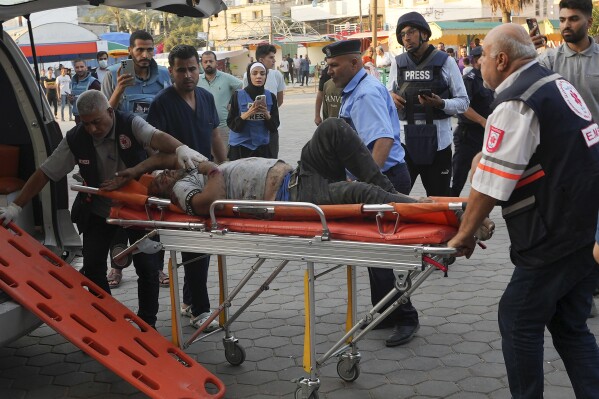‘Drop in the ocean': UN-backed aid could soon enter Gaza from Egypt, but only at a trickle for now
CAIRO (AP) — President Joe Biden says he struck a deal with his Egyptian counterpart to allow a first run of 20 trucks carrying humanitarian aid to enter Gaza, which Israel sealed off after the Hamas attack on Oct. 7.
Israel says it’s now ready to honor Biden’s request to let in limited humanitarian aid.
The Egyptian and Palestinian Red Crescent Societies and the United Nations are expected to help oversee the operation, in part to ensure the supplies from the convoy through the Rafah Crossing on Egypt’s border with Gaza reaches civilians — not combatants.
Official at the U.N. health agency say they’re “praying” the first tranche will go in on Friday.
 More than 300 are arrested in a Capitol Hill protest urging a cease-fire in the Israel-Hamas war
More than 300 are arrested in a Capitol Hill protest urging a cease-fire in the Israel-Hamas war
 While visiting wartime Israel, New York governor learns of her father’s sudden death back home
While visiting wartime Israel, New York governor learns of her father’s sudden death back home
 Journalists in Gaza wrestle with issues of survival in addition to getting stories out
Journalists in Gaza wrestle with issues of survival in addition to getting stories out
Here’s a look at what could be expected to go in, and how.
WHAT THE TRUCKS WILL CARRY
The United Nations and its various agencies — the World Health Organization, the World Food Program, and children’s agency UNICEF among them — along with partners like Red Cross and Red Crescent groups are accustomed to moving needed goods to troubled areas.
They often move in what’s called an “inter-agency convoy,” meaning a hodgepodge of aid groups.
At a news briefing Thursday, WHO’s emergencies chief, Dr. Michael Ryan, waved a paper in the air with a long list of medical supplies that his agency hopes to get into Gaza with five truckloads that it has at the ready: amputation kits, intubation kits, pneumothorax kits for people with punctured lungs, wound dressings, anesthetics and painkiller.
WFP spokesman Martin Rentsch said some 951 metric tons (1000 tons) of food were at the border or on their way there, enough to feed nearly a half-million people for a week. He said high-energy biscuits and canned foods that don’t need to be cooked were often deployed in such urgent situations.
Jan Egeland, head of the Norwegian Refugee Council aid group, said: “Hamas doesn’t need baby food and bottled water – we are talking about saving children, and pregnant women and families.”
HOW THE AID WILL BE DISTRIBUTED
The deal brokered between Egypt and Israel would involve U.N. observers inspecting aid trucks before they enter Gaza, and the hoisting of U.N. flags on both sides of the Rafah crossing to ward off any Israeli airstrikes, an Egyptian official and a European diplomat told The Associated Press.
They spoke on condition of anonymity because they were not authorized to brief media.
Egyptian and Israeli officials were still negotiating about whether fuel — needed to run hospital generators and water desalination plants, among other things — would be allowed in, the Egyptian official said. Israel wants to make sure Hamas doesn’t seize any of the aid, especially fuel.
Once inside Gaza, the convoy will need to navigate gingerly through bombed-out areas or pock-marked roads before reaching distribution points — like hospitals, some of which have already been hit by military firepower during the conflict.
WHAT 20 TRUCKS AMOUNT TO
The U.N. Office for the Coordination of Humanitarian Affairs, in its latest update, estimated about 3,000 metric tons (3300 tons) of goods were in Egypt just across the border from Gaza, awaiting entry. An OCHA spokeswoman declined to comment on Thursday about preparations for the convoy.
Sarah Davies, a spokesperson for the International Committee of the Red Cross, said its trucks between the northern Egyptian city of El Arish and Gaza can each hold between 10 and 20 tons of aid. WFP’s Rentsch said its trucks can carry a bit more.
Last year, some 60% of Palestinians in Gaza needed humanitarian assistance, OCHA says. In calmer times, hundreds of Palestinians pass through Rafah crossing multiple times a week, many departing on religious pilgrims or commuting to work in Egypt.
The Israeli-controlled Kerem Shalom and Erez crossings, like the one in Rafah, are now closed. OCHA said over 32,300 truckloads of goods entered Gaza through Rafah last year, and more than twice that went through Kerem Shalom.
WHO’s Ryan lamented that 20 trucks “is a drop in the ocean of need right now in Gaza ... it shouldn’t be 20 trucks. It should be 2,000 trucks. And we shouldn’t have to be making these choices.”
In Cairo on Thursday, where he was observing the world body’s preparations to send “massive” support to Gazans, U.N. Secretary-General António Guterres reiterated his call for a “humanitarian ceasefire” and said any deliveries — after nearly two weeks with Gaza cut off — should continue.
“For nearly two weeks, the people of Gaza have gone without any shipments of fuel, food, water, medicine and other essentials,” he said. “Civilians in Gaza desperately need core services and supplies – and for that we need rapid, unimpeded humanitarian access.”
___
Keaten reported from Geneva. Samy Magdy in Cairo contributed to this report.
Disclaimer: The copyright of this article belongs to the original author. Reposting this article is solely for the purpose of information dissemination and does not constitute any investment advice. If there is any infringement, please contact us immediately. We will make corrections or deletions as necessary. Thank you.





